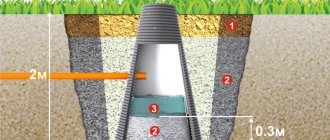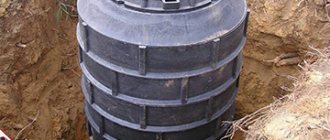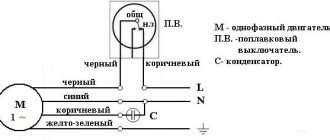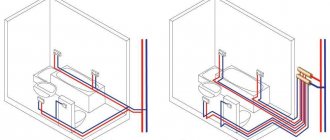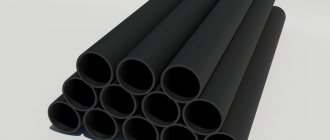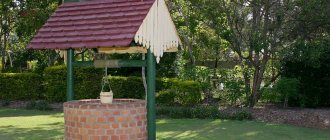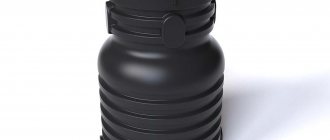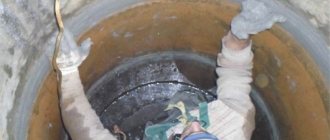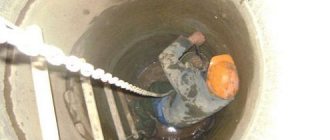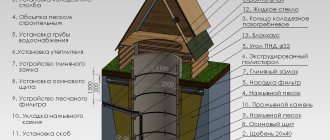The problem of wastewater disposal and purification is well known to all owners of country houses who do not have access to a centralized sewerage system.
As a universal solution, many people use a filter well, which helps to efficiently drain and purify water. At the same time, the costs of constructing this structure are minimal compared to other options.
How many filter wells are needed on the site, how is their size calculated?
The number of structures on a particular site is determined based on the volume of water a family consumes per day. As a rule, for high-quality operation of one septic tank, you need 3 wells. In this case, the volume of the septic tank is at least two times greater than the daily flow rate.
On average, 250 liters of water are allocated per person per day. Accordingly, a family of 3 people requires a septic tank with a volume of 2.5 m³.
When determining the load on a well, take into account the composition of the soil and the distance from the structure to groundwater. If it is more than 2.5 meters, increase the load by 25%.
Advice! Where filtration is required only in the summer months - for example, at dachas, the load on the absorber is also calculated with a margin.
The structural design of such a structure
Like any work, the construction of a filter well requires a thoughtful strategy and thorough preparation. It is advisable to install a well in cases where the soil is sand and sandy loam, groundwater flows at depths exceeding 2.5 m. To do this, you should study the basics of the theory and the design of a filter well.
Diagram of the filter well - typical components and their parameters
The treatment plant is a deep shaft, the “inside” of which is a well. It consists of a top floor, walls and a bottom with filtered material.
Important: the size of the shaft must be 0.8 m larger than the parameters of the septic tank.
Is it possible to make a filter well with a high groundwater level?
In addition to the fact that each specific absorber model is focused on a specific soil composition, the groundwater level plays an important role.
If the ground does not drain water well, the system will not work effectively and the quality of cleaning will be poor. Depth of occurrence can negatively affect filtration processes.
Reference! Experts do not recommend installing wells in places with high groundwater levels precisely because it is impossible to absorb water into the soil. The optimal distance from the filter to the water mains water supply is 1 meter.
Functions
Functions of the well - water purification
A filter well is designed for processing and recycling wastewater by purifying and “transferring” water into the ground, thereby removing it from the site. For such a structure to function normally, sandy or sandy loam soils are required. When building it, it is necessary that there is a distance of 30 meters between the well and the house. Building a filter well with your own hands is not easy, but it is possible.
How to choose the right type of filter well
Which design and material to choose for absorber manufacturing depends on a number of factors:
- amount of water consumed;
- soil composition;
- financial opportunities.
Comparison of structures with walls made of different materials and with different filters
Both natural and artificial materials are used as filters. The main condition is that the drainage should not decompose upon contact with water. Toxic and biohazardous components cannot be used as a filter.
Optimal materials:
- quartz;
- pebbles;
- crushed stone;
- river sand.
Advice! It is better not to use the remains of building materials as a drainage layer.
The materials most often chosen for installing wells are:
- brick is a high-quality and durable material. Advantages: reliable design; all work can be done alone. Disadvantages - high cost of installation;
- Concrete rings are quickly installed and last a long time. Helpers will be needed to install the structure;
- plastic - a budget option for water purification. Terms of use are limited. The material is afraid of low temperatures and mechanical influences. Requires enhanced waterproofing;
- old car tires - a well can be made from them quickly; in addition to rubber, you only need plastic brackets for fixing, a sewer pipe and insulation. Suitable only for use in the countryside, as it is afraid of frost.
Comparison of conical and cylindrical well
Let's consider the comparative characteristics of two options for filter wells - conical and cylindrical.
Conical
Used for wastewater disposal that has been pre-filtered in septic tanks and treatment systems. The structures are made from a special corrugated pipe - it performs a cleaning function. Two options are used:
- without perforation;
- with perforation.
The diameter of both pipe options is 6.3 cm.
The advantage of a conical well is the ability to install equipment in soils with different compositions.
Cylindrical
Cylindrical models are made of polypropylene. Their main difference from the conical versions is their limited use. For example, it is better not to install them in soil with a high concentration of clay.
The cylinder tube has a diameter of 100 cm and a height of 300.
Like conical filters, cylinder-shaped filters are inexpensive and easy to install.
How to make a filtration well with your own hands
You can make a filter absorber yourself. As materials, choose the one that is more convenient.
Brick construction
The shape of a brick well can be made round or square. Moreover, the first option is more convenient to use, and the second is easier to manufacture. The diameter of the structure is 200 x 200 cm. Depth is 200-250 cm.
The hole for the well is made with reserve. A drainage layer is placed between the walls of the structure and the ground. Crushed stone, gravel, broken brick will do.
The thickness of the layer is 400 mm. Height - 100 cm.
To prevent the walls at the location of the filter from allowing water to pass through, the masonry is made with holes. They are made in a checkerboard pattern. Size - 3-4 cm. After construction is completed, they are sprinkled with drainage filler.
The bottom of the well is lined with a layer of filter materials. Its height is 1 meter. They take different fractions - the larger ones are placed on the bottom, the smaller ones are sprinkled on top. Leave a hole for the sewer pipe. A special sheet of plastic is placed in the area where the liquid will flow from - it will prevent the filter from washing out.
A hatch is installed on top. Provide ventilation.
Construction made of concrete rings
A well made from ready-made rings is the simplest filter option.
Step-by-step instruction:
- dig a hole - its diameter is 50 cm wider than the concrete rings;
- lower the perforated block down the structure;
- install the first ring. Remove the soil from inside the workpiece. Over time, the ring will sag a little under its own weight;
- mount the remaining two concrete elements in the same way;
- Place drainage in the space between the walls of the well and the ground, as well as at the bottom of the structure. Next - the hatch and ventilation according to the standard scheme.
Well made from old tires
Car tires are the cheapest option to solve the problem of water filtration. Moreover, the structure will perfectly fulfill its function for a family of 3-4 people.
The disadvantage of such wells is that rubber is not suitable for use in the cold season. Consequently, these absorber models can only be used in the country.
At low temperatures the material freezes completely.
Step-by-step instructions for making a filter:
- dig a pit;
- drop a few tires into it;
- stack one on top of the other. Secure the device with plastic clamps;
- Apply sealant to the joints - it will enhance the grip of the tires and give the structure stability;
- further - according to the scheme described above.
General provisions
First of all, let's get acquainted with the functionality of such a device and its alternatives.
Functions
The filter well has the following purposes:
- Filtration of wastewater that comes out of the septic tank after the preliminary stages of treatment. The process is carried out using a bottom filter located at the base of the structure.
Advice: if we are talking about a dacha where you do not live permanently, and its volume of wastewater does not exceed one cubic meter per day, then you can get by with just well cleaning without a septic tank. This will significantly save your budget.
Connection to septic tank
- Creation of a garden irrigation system. Ultimately, if the technology is followed, the liquid has a sufficient degree of purification for use as a watering plant.
- Localization of pollution. The wastewater will not spontaneously spill over the site, but will end up in a strictly designated place for it.
Alternatives
It should be noted that this is not the only way to purify water after a septic tank.
Also applicable:
- Absorption trenches. Low price, but poor level of cleaning and requires a lot of space.
- Sand and gravel filters. Poor localization, there is a possibility of dirty liquid getting directly into the ground.
- Underground filtration field. After several years of using this option, it is necessary to move the entire sewer system to another location due to the unsuitability of the soil for further treatment.
Soil filtration implementation scheme
The use of a well, although it requires some moderate costs and labor to create, is the most rational structure for purifying waste liquid.
How to install a filtration well
Decide what shape the well will be. Carry out calculations - calculate the area of the structure. Make a drawing.
Advice! Look at thematic sites on the Internet - here you can find a ready-made well project that will suit your calculations.
Step-by-step algorithm of actions:
- dig a pit;
- Lay a masonry 100 cm high from concrete rings or bricks. Make uniform holes for the exit of liquid;
- then make even masonry, without holes - the walls should be solid;
- install a sewer pipe. Place it just above the bottom filter. Make a slight incline. Place the open part of the pipe in the center of the pit. Place a container underneath to collect water;
- make a ceiling and install a hatch. Don't forget that there should be two covers - we discussed why in the previous section. The diameter of the hole is 70 cm. Provide waterproofing. Lay insulation on top of the structure and between the covers;
- fill the structure with soil. Leave space for ventilation outlet. Place the pipe to the side of the filter.
Maintenance and operation of filter wells
Care and maintenance of a well is a prerequisite for its high-quality operation. In order for the structure to serve for a long time, follow the rules of maintenance and operation:
- Periodically remove dirt from the filter. Do preventive measures - do not use the well for several days - let the water go away;
- loosen the drainage, regularly add a new filter, take away the used one;
- When the filter becomes silted, use industrial cleaning products.
Perform scheduled cleaning as follows:
- drain water from the well using a sewer truck;
- dissolve the pH solution in water and pour it into the well;
- mix hot water and stabilizer, pour inside for several hours;
- Mix Bionet Super with water, pour into the well, stir.
Advice! To prevent filter clogging, pour a bioactivator bag into the pit twice a month in the proportion: 1 dose per 1 m³.
